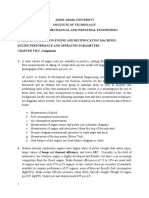Assignment_3
Uploaded by
tadesse.wasie1221Assignment_3
Uploaded by
tadesse.wasie1221Department of Mechanical Engineering, IIT Madras, Chennai
ME5010: Hybrid and Electric Vehicle Technology
Assignment 3: Problems on well-to-wheel analysis
1. A four-stroke, gasoline-based engine has a fuel consumption of 0.278 g/s and delivers a load
of 10 Nm while operating at 3000 rpm. (The calorific value of fuel is 43 MJ/kg and specific
gravity is 0.7).
Consider the following efficiencies as required: Extraction = 93%, Processing = 95%,
Distribution = 99%, and Powertrain = 91%. Also consider the GHG emission factor for
gasoline as 2778.2 g CO2e/L.
Find the well-to-wheel efficiency of the engine.
If the vehicle runs for a total of 1.5 hours (without stopping) with an average velocity of
45 km/hr, find the WTW GHG emissions in g CO 2e/km.
Based on the above arrived values, what could be the possible class of the vehicle?
2. For an EV, if the electricity used for its charging comes from the following sources: 40% coal,
10% natural gas, 25% solar, 5% nuclear, and 20% hydro. The EV has a battery of 3 kWh which
could drive till 95 km.
Find the well-to-wheel efficiency of the EV.
Find the WTW GHG emissions in g CO2e /km.
3. Develop the BSFC (g/kWh) contours plot over torque (Nm) versus speed (rpm) for the engine
data (obtained experimentally) provided to you in a separate excel file. (Consider the torque
values starting from 3.5 to 12 Nm at 0.5 step interval for plotting purposes).
Hint: You could use any curve fitting tools (excel or any other advanced tools) available to you
for extracting values at certain points or intermediate values needed for plot.
You might also like
- Beng (Hons) Automobile Engineering 2 Examinations 3 4 Power Train Technology 3 ATT3012No ratings yetBeng (Hons) Automobile Engineering 2 Examinations 3 4 Power Train Technology 3 ATT30128 pages
- Implementation of Micro Turbine With Heat Recovery System in Vehicle BusNo ratings yetImplementation of Micro Turbine With Heat Recovery System in Vehicle Bus3 pages
- Angelo S. Tamaño: Power Plant EngineeringNo ratings yetAngelo S. Tamaño: Power Plant Engineering22 pages
- Applications-Powertrain Sizing-BEV Battery SizingNo ratings yetApplications-Powertrain Sizing-BEV Battery Sizing28 pages
- Energy Management Strategy For A Hybrid Electric VehicleNo ratings yetEnergy Management Strategy For A Hybrid Electric Vehicle10 pages
- Mathematical Modelling and Simulation of Spark Ignition Engine For Predicting Engine Performance CharacteristicsNo ratings yetMathematical Modelling and Simulation of Spark Ignition Engine For Predicting Engine Performance Characteristics5 pages
- Adaptive Control Using Map-Based ECMS For A Phev: Linköping University Post PrintNo ratings yetAdaptive Control Using Map-Based ECMS For A Phev: Linköping University Post Print7 pages
- Performance Investigation of A Series-Parallel Petrol-Electric VehicleNo ratings yetPerformance Investigation of A Series-Parallel Petrol-Electric Vehicle5 pages
- Comsats Institute of Information Technology SahiwalNo ratings yetComsats Institute of Information Technology Sahiwal2 pages
- Cw1 Part1 M21mae David Chaves Sid8378556No ratings yetCw1 Part1 M21mae David Chaves Sid837855622 pages
- MEET 422L2 - Prelims - Experiment 2 - HP Eff - Gear Speed RatiosNo ratings yetMEET 422L2 - Prelims - Experiment 2 - HP Eff - Gear Speed Ratios5 pages
- Novel Operation and Control of An Electr PDFNo ratings yetNovel Operation and Control of An Electr PDF12 pages
- Challenges To Improve Energy Efficiency in Oil Refineries When Modernizing Electric Motor Systems (Final)No ratings yetChallenges To Improve Energy Efficiency in Oil Refineries When Modernizing Electric Motor Systems (Final)20 pages
- Elaboration On Calculations of Automobile Fuel Consumption: Journal of Physics: Conference SeriesNo ratings yetElaboration On Calculations of Automobile Fuel Consumption: Journal of Physics: Conference Series8 pages
- Hybrid Power System With Variable Speed Diesel EngineNo ratings yetHybrid Power System With Variable Speed Diesel Engine6 pages
- Trade-Offs Between Fuel Economy and Nox Emissions Using Fuzzy Logic Control With A Hybrid CVT ConfigurationNo ratings yetTrade-Offs Between Fuel Economy and Nox Emissions Using Fuzzy Logic Control With A Hybrid CVT Configuration13 pages
- ME 416 (ME 4) Internal Combustion Engine Practice ProblemsNo ratings yetME 416 (ME 4) Internal Combustion Engine Practice Problems3 pages
- ME 28 Power Plant Engineering Lec Prelim ExamNo ratings yetME 28 Power Plant Engineering Lec Prelim Exam2 pages
- Reaserch on an Electronic Control System of CNGDiesel Dual Fuel Engine (Lv, Xiao Ning Qin, Jiang Tao Li, Jing Bo Zou etc.)No ratings yetReaserch on an Electronic Control System of CNGDiesel Dual Fuel Engine (Lv, Xiao Ning Qin, Jiang Tao Li, Jing Bo Zou etc.)5 pages
- Performance Analysis of A Spark Ignition Engine Using Compressed Natural Gas (CNG) As FuelNo ratings yetPerformance Analysis of A Spark Ignition Engine Using Compressed Natural Gas (CNG) As Fuel8 pages



























































